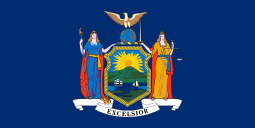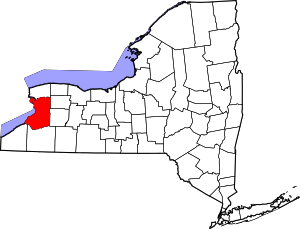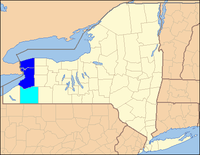Lackawanna, New York
| Lackawanna, New York | |
|---|---|
| City | |
|
Lackawanna's City Hall | |
 Location of Lackawanna in Erie County and New York | |
 Lackawanna Location of Lackawanna in Erie County and New York | |
| Coordinates: 42°49′10″N 78°49′32″W / 42.81944°N 78.82556°WCoordinates: 42°49′10″N 78°49′32″W / 42.81944°N 78.82556°W | |
| Country | United States |
| State | New York |
| County | Erie |
| Government | |
| • Type | Mayor-Council |
| • Mayor | Geoffrey M. Szymanski (D) |
| • City Council |
Members' List
|
| Area | |
| • City | 6.6 sq mi (17.1 km2) |
| • Land | 6.6 sq mi (17.0 km2) |
| • Water | 0.04 sq mi (0.1 km2) |
| Elevation | 623 ft (190 m) |
| Population (2010)[1] | |
| • City | 18,141 |
| • Density | 2,761/sq mi (1,065.9/km2) |
| • Metro | 1,254,066 |
| Time zone | EST (UTC−5) |
| • Summer (DST) | EDT (UTC−4) |
| ZIP code | 14218 |
| Area code(s) | 716 |
| FIPS code | 36-40189 |
| GNIS feature ID | 0954863 |
| Website |
www |
Lackawanna is a city in Erie County, New York, United States, located just south of the city of Buffalo in the western part of New York state. The population was 18,141 at the 2010 census.[2] The name derives from the Lackawanna Steel Company.[3] It is part of the Buffalo-Niagara Falls metropolitan area. The city of Lackawanna is in the southwestern part of the county. It is part of the Southtowns.
Government
The city of Lackawanna has a mayor-council form of government. A councilman is elected from each of the four wards of the city, considered single-member districts. The mayor and council president are elected at-large. Fire and police services are also provided by city-run departments.[3]
History
Originally part of the Buffalo Creek Reservation, the area was not open to settlement until 1842 when the land was sold by the Seneca Indians. In 1851 the town of Seneca was formed; the name was changed to West Seneca in 1852. The area now known as Lackawanna was then called West Seneca or Limestone Hill.
Lackawanna was a center of steel manufacture throughout most of the 20th century. In 1899 all the land along the West Seneca shore of Lake Erie was purchased by the Lackawanna Steel Company, based in Scranton, Pennsylvania since its founding. Construction was started in 1900 and the Lackawanna Steel Company relocated to the area in 1902. The plant began operations in 1903. Later, in 1909, the residents of the area voted to split off from West Seneca, forming the city of Lackawanna.[3]
In 1922 the Lackawanna Steel Company was acquired by the Bethlehem Steel Company. With the 20th-century growth of the Bethlehem Steel plant, at one time the largest in the world, came the continued growth of the city and its institutions. At its peak the plant employed 20,000 people. It attracted immigrants from many lands to settle here and make their homes. Due to industrial restructuring in the latter half of the 20th century, the steel plant declined in business and eventually closed in 1983, following massive job layoffs.[4]
In the 21st century, efforts have been made to develop the former steel plant brownfields to other uses. The site has a diversity of tenants, some occupying buildings remaining from the former steel plant and a few in newer buildings. Opponents say that the brownfield is not safe and that alleged contamination of the field has caused cancer and other medical issues.[5] United States Environmental Protection Agency reports are still ongoing and contested.[6]
As part of redevelopment, wind turbines were built on the former Bethlehem Steel property in 2007. These initial eight 2.5 megawatt turbines will provide power for up to 9,000 households and are considered a sustainable energy source.[7]
The Buffalo Harbor South Entrance Light was listed on the National Register of Historic Places in 2007.[8]
On November 9, 2016, a major fire broke out at the former galvanizing plant of the Bethlehem Steel complex.
Railroads
The Delaware, Lackawanna and Western Railroad, originally the Lackawanna and Western Railroad, operated from 1851 to 1960. In 1960 it was consolidated with the Erie Railroad to become the Erie Lackawanna Railway. This operated until 1976, when it was absorbed by Conrail.
Notable court case
The city of Lackawanna was the defendant in the 1971 district court decision Kennedy-Park Homes Association v. City of Lackawanna. This decision forbade the municipal government (Lackawanna) from interfering with the construction of a low-income housing development in a predominantly white section of the city. The court ruled that such action would amount to racial discrimination.[9]
The Lackawanna Six
The Lackawanna Six (also known as the Buffalo Six) are a group of Yemeni Americans who were convicted of providing "material support" to Al-Qaeda. The group was accused of traveling to Afghanistan and Pakistan in the spring of 2001 to attend terrorist training camps.[10] The men had claimed that their travel was to Pakistan only, and for the purpose of religious instruction.
The group was arrested in Lackawanna on September 13, 2002, by the FBI. A member of the Lackawanna Cell, Jaber A. Elbaneh, never returned to the U.S. after his trip to Afghanistan. In September 2003 the FBI announced a $5 million reward for information leading to his arrest. Captured by Yemen police, he was convicted and sentenced to a prison in Yemen for involvement in the 2002 bombing of the French oil tanker Limburg off the coast of Yemen. The remaining members of the group pleaded guilty in December 2003 and were given various sentences in federal prison.[11]
Jaber Elbaneh escaped from a Yemeni prison in 2006 after joining a successful group prison break. He was identified as one of 23 people, 12 of them Al-Qaeda members, who escaped on February 3, 2006. On February 23, 2006, the FBI confirmed the escape, as they issued a national press release naming Elbaneh to the FBI Most Wanted Terrorists list.[12] On May 20, 2007, Elbaneh turned himself in to Yemen authorities on the condition that his prison sentence would not be extended. The incident of the Lackawanna Six has tarnished the city's reputation, but it is recovering.[13]
In July 2009, it was reported that prior to authorities sending in 130 federal and local members of the Western New York Joint Terrorism Task Force, there were suggestions that federal troops be used to capture the suspects.[14] At the time, Vice President Dick Cheney and Defense Secretary Donald Rumsfeld believed that the Yemeni men should be declared enemy combatants and could have been tried by a military tribunal. President Bush rejected this proposal, and the arrests proceeded without incident.[14]
Religious institutions
The city of Lackawanna is home to fourteen Protestant churches, the Masjid Alhuda Guidance Mosque (the largest mosque in the Buffalo area), ten Roman Catholic churches, including Our Lady of Victory Basilica (OLV); and Saint Stephen Serbian Orthodox Church.
Our Lady of Victory Basilica

Our Lady of Victory Basilica, located in Lackawanna, is a National Shrine. Next to the basilica is Holy Cross Cemetery. It has been a parish cemetery since 1849, although burials date back to 1830. Father Nelson Baker was responsible for the building of a working boys' home (protectory) in 1898. He also supervised construction of an infants' home in 1907, a maternity home in 1915, Our Lady of Victory Hospital in 1919, and the Basilica of Our Lady of Victory in 1926. Father Baker named the basilica after the shrine of Notre Dame des Victoires in Paris, which he visited as a seminarian in 1874. He was in charge of the basilica and the various institutions of charity until his death at 94, on July 29, 1936.
Father Baker's social programs have evolved into Baker Victory Services, which care for more than 2,500 children each day. Baker Victory Services Adoption Program has evolved into a renowned resource for a wide range of adoptive services. Their mission is to assist birth mothers, families and adoptees through the often complex and always emotional adoption process. Our Lady of Victory Hospital, closed in 1999, is being converted into senior housing.[15][16] The Homes of Charity provide the funds to continue Baker's social programs through donations.
Our Lady of Victory Basilica had its 75th anniversary in 2001. The Catholic Church named Father Baker a "Servant of God" in 1987, the first step towards declaring him a saint. In 1999, Father Baker's remains were moved from Holy Cross Cemetery and re-interred inside the basilica. This was a recommended step for his canonization process. On January 14, 2011, Pope Benedict XVI approved a document of the Congregation for the Causes of Saints declaring Father Baker "Venerable." His cause for canonization, as an "apostle of charity," continues under review by Vatican officials.[17][18]
Geography
According to the United States Census Bureau, the city has a total area of 6.6 square miles (17.1 km2), of which 0.04 square miles (0.1 km2), or 0.75%, is water.[2] Lackawanna sits on Lake Erie, although the waterfront is occupied by the remnants of the Bethlehem Steel facility. Smokes Creek (named after Seneca Indian Chief Sayenqueraghta who was nicknamed "Old Smoke") runs through the city before it discharges into Lake Erie.
Abbott Road is a major road that runs north–south through the city. Ridge Road is a main east–west road in the city.
Adjacent cities and towns
- City of Buffalo—north
- Town of West Seneca—east
- Town of Orchard Park—southeast
- Town of Hamburg—south
- Village of Blasdell—south
- Lake Erie—west
Major highways
-

 Interstate 90 (New York State Thruway), runs through the extreme southeast corner of the city.
Interstate 90 (New York State Thruway), runs through the extreme southeast corner of the city. -
 U.S. Route 62 (South Park Ave.), North-South roadway that runs through the city from Buffalo into Blasdell and Hamburg.
U.S. Route 62 (South Park Ave.), North-South roadway that runs through the city from Buffalo into Blasdell and Hamburg. -
 New York State Route 5 (Fuhrmann Blvd., Hamburg Tprk.), North-South (signed east-west) roadway through the city that runs from Hamburg to Buffalo. Busy north-south (signed east-west) route for traffic to and from Buffalo.
New York State Route 5 (Fuhrmann Blvd., Hamburg Tprk.), North-South (signed east-west) roadway through the city that runs from Hamburg to Buffalo. Busy north-south (signed east-west) route for traffic to and from Buffalo.
Demographics
| Historical population | |||
|---|---|---|---|
| Census | Pop. | %± | |
| 1910 | 14,549 | — | |
| 1920 | 17,918 | 23.2% | |
| 1930 | 23,948 | 33.7% | |
| 1940 | 24,058 | 0.5% | |
| 1950 | 27,658 | 15.0% | |
| 1960 | 29,564 | 6.9% | |
| 1970 | 28,657 | −3.1% | |
| 1980 | 22,701 | −20.8% | |
| 1990 | 20,585 | −9.3% | |
| 2000 | 19,064 | −7.4% | |
| 2010 | 18,141 | −4.8% | |
| Est. 2015 | 17,965 | [19] | −1.0% |
As of the census[21] of 2000, there were 19,064 people, 8,192 households, and 4,775 families residing in the city. The population density was 3,114.0 people per square mile (1,202.7/km²). There were 8,951 housing units at an average density of 1,462.1 per square mile (564.7/km²). The racial makeup of the city was 83.99% White, 9.50% African American, 0.40% Native American, 0.31% Asian, 0.01% Pacific Islander, 2.30% from other races, and 3.49% from two or more races. Hispanic or Latino of any race were 5.08% of the population. The population of whites includes a significant Yemeni population.
There were 8,192 households out of which 26.0% had children under the age of 18 living with them, 37.2% were married couples living together, 16.5% had a female householder with no husband present, and 41.7% were non-families. Of all households 37.0% were made up of individuals and 15.9% had someone living alone who was 65 years of age or older. The average household size was 2.30 and the average family size was 3.06.
In the city the population was spread out with 24.5% under the age of 18, 8.5% from 18 to 24, 28.0% from 25 to 44, 20.4% from 45 to 64, and 18.5% who were 65 years of age or older. The median age was 38 years. For every 100 females there were 92.3 males. For every 100 females age 18 and over, there were 87.5 males.
The median income for a household in the city was $29,354, and the median income for a family was $39,237. Males had a median income of $32,063 versus $22,794 for females. The per capita income for the city was $16,727. About 13.1% of families and 16.7% of the population were below the poverty line, including 27.4% of those under age 18 and 9.0% of those age 65 or over.
Education
Public
Children in Lackawanna attend school in the Lackawanna City School District. Grades Pre-K to 2 attend Truman Elementary School. Martin Road Elementary School has grades 3-6. In a shared building, Grades 7 through 8 are in the Lackawanna Middle School section and Grades 9 through 12 are in Lackawanna High School section.[22] Lackawanna Senior High School was famous in the 1960s and early 70s because of its dominant football teams (quarterbacked by Ron Jaworski for some of those years).
Private
Our Lady of Victory Elementary School, a private school affiliated with the Roman Catholic Church, offers education from Kindergarten through Grade 8.[23] The Global Concepts Charter School, a charter school in the New York State system, offers education from Kindergarten through Grade 10.[24]
Notable people from Lackawanna
- R. J. Adams aka Bob Shannon, film/TV actor, radio personality (WKBW)[25]
- Father Nelson Baker, Roman Catholic priest responsible for building the Basilica of Our Lady of Victory. This "Padre of the Poor" established social programs (for orphans, people with disabilities, unwed mothers, etc.), which still serve over 2,500 people a day.
- John Batorski, former professional football player
- Ann Burke, Second (after Sports Babe) female sports radio call-in host in America (Bob & Ann Show, WGR)
- Raymond Castilloux, racing cyclist, winner of first place classification at New York Central Park representing US cycling team at the Tokyo 1964 Olympics
- Raymond F. Gallagher, former New York State Senator
- Marie Gannon, former Erie County legislator
- Joe Hesketh, former Major League Baseball pitcher who played from 1984 through 1994 for the Montreal Expos, Atlanta Braves and Boston Red Sox
- Ron Jaworski, ESPN broadcaster and former quarterback for the Philadelphia Eagles, Los Angeles Rams, Miami Dolphins, and Kansas City Chiefs[26]
- Daniel M. Kozub, former Erie County legislator and City of Lackawanna Councilmember
- Edward J. Kuwik, former Erie County legislator
- Mike Mamula, defensive lineman at Boston College who was selected #7 in the first round by the Philadelphia Eagles in the 1995 NFL draft[27]
- Pat McMahon, former college baseball coach
- John C. Ogarek, former Erie County Legislator and Mayor of Lackawanna
- John R. Pillion, former US congressman
- Mark Poloncarz, current county executive of Erie County and a 2004 and 2008 delegate to the Democratic National Committee's National Convention
- Francis J. Pordum, former New York State Assemblyman
- Frederick F. Pordum, former Erie County Legislator
- Connie Porter, author best known for her books for children and young adults[28] Her novel All-Bright Court is set in Lackawanna.
- Ruben Santiago-Hudson, actor and playwright. He set his musical Lackawanna Blues in the Lackawanna community of 1956.[29] Major acting role was in ABC series "Castle." In 1996 he received Tony Award for performance in "Seven Guitars".
- Dick Shawn, actor/comedian/singer who was born Richard Schulefand. His parents owned a store in Lackawanna. Dick Shawn appeared in The Producers and It's a Mad, Mad, Mad, Mad World among others.
- Dr. Lonnie Smith, award-winning jazz organist who has worked closely with George Benson; he has also appeared with Dizzy Gillespie, Gladys Knight, and Dionne Warwick.
- Margaret M. Sullivan, New York Times public editor who also serves on the Pulitzer Prize Board. Previously editor of The Buffalo News.[30]
- John B. Weber, became the youngest colonel (age 20) in the Civil War after his appointment to the 89th United States Colored Infantry. He was elected to Congress and served one term from 1885 to 1889. Weber was also the first commissioner of the immigration station at Ellis Island
Photos of Lackawanna
 Lackawanna's Veterans Stadium (formerly Ron Jaworski Stadium)
Lackawanna's Veterans Stadium (formerly Ron Jaworski Stadium) Wind turbines of the Steel Winds project at former Bethlehem Steel plant along Lake Erie
Wind turbines of the Steel Winds project at former Bethlehem Steel plant along Lake Erie Entrance to the former Our Lady of Victory Hospital
Entrance to the former Our Lady of Victory Hospital South Park Avenue entrance to Holy Cross Cemetery
South Park Avenue entrance to Holy Cross Cemetery
See also
-
 New York portal
New York portal
References
- ↑ Metropolitan & Central City Population: 2000-2005. Demographia.com, accessed September 3, 2006.
- 1 2 "Geographic Identifiers: 2010 Demographic Profile Data (G001): Lackawanna city, New York". U.S. Census Bureau, American Factfinder. Retrieved February 22, 2016.
- 1 2 3 "History of the City of Lackawanna". Welcome to the City of Lackawanna Official Website. Retrieved 3 July 2009.
- ↑ "Bethlehem Rejects Lackawanna Plan". The New York Times. March 18, 1983. Retrieved 3 July 2009.
- ↑ DePalma, Anthony; Staba, David (December 23, 2007). "Sickened, and Fighting Another Cold War". CCAM NEWS 2007 part 4. Mothball Millstone! Connecticut Coalition Against the Millstone Nuclear Power Reactor. Retrieved 3 July 2009.
- ↑ Senator Hillary Rodham Clinton Statement & Releases March 20, 2006
- ↑ "About Steel Winds". Steel Winds.com. Retrieved 3 July 2009.
- ↑ National Park Service (2010-07-09). "National Register Information System". National Register of Historic Places. National Park Service.
- ↑ "436 F. 2d 108 - Kennedy Park Homes Association v. City of Lackawanna, New York". OpenJurist. Retrieved 1 January 2011.
- ↑ Purdy, Matthew; Lowell Bergman (October 12, 2003). "WHERE THE TRAIL LED Unclear Danger: Inside the Lackawanna Terror Case". The New York Times. Retrieved 2007-09-08.
- ↑ Aziz, Roya; Monica Lam. "Profiles: The Lackawanna Cell". Chasing the Sleeper Cell. Retrieved 3 July 2009.
- ↑ "Recent Escapees from Yemen Prison Added to Most Wanted Terrorists and Seeking Information - War on Terrorism Lists". Federal Bureau of Investigation. February 23, 2006. Retrieved 1 January 2011.
- ↑ Vezner, Tad (February 26, 2006). "The lessons of Lackawanna: Terror case leaves lasting mark on New York town". The Toledo Blade. Retrieved 2007-09-08.
- 1 2 Michel, Lou (July 26, 2009). "Lackawanna officials say troops in city was bad idea". The Buffalo News. Retrieved 27 July 2009.
- ↑ Thrall, Terese Hudson (April 2007). "Design & Construction - Finding a New Use for an Old Hospital". Hospital & Health Networks. Retrieved 3 July 2009.
- ↑ "Design - Hospital finds new life in senior housing". Health Facilities Management. Retrieved 3 July 2009.
- ↑ "The Road to Sainthood". Father Nelson Baker - The Apostle of Charity. Our Lady of Victory.org. Retrieved 3 July 2009.
- ↑ Villarrubia, Eleonore (January 31, 2006). "The Servant of God, Father Nelson Baker". Catholicism.org. Retrieved 3 July 2009.
- ↑ "Annual Estimates of the Resident Population for Incorporated Places: April 1, 2010 to July 1, 2015". Retrieved July 2, 2016.
- ↑ "Census of Population and Housing". Census.gov. Retrieved June 4, 2015.
- ↑ "American FactFinder". United States Census Bureau. Retrieved 2008-01-31.
- ↑ "Lackawanna City School District". Retrieved 3 July 2009.
- ↑ "Our Lady of Victory Elementary School". Retrieved 3 July 2009.
- ↑ "Global Concepts Charter School Homepage". Retrieved 3 July 2009.
- ↑
- ↑ Ron Jaworski.com Biography
- ↑ "Mike Mamula". The Sporting News. Retrieved 3 July 2009.
- ↑ "Biography: Connie Porter". Uncrowned Queens - African American Community Builders. Retrieved 3 July 2009.
- ↑ "Lackawanna Blues (2005) (TV)". The Internet Movie Database. Retrieved 3 July 2009.
- ↑ Garcia, Camille P. (September–October 2006). "Life at the top of One News Plaza: Margaret M. Sullivan". 10 of the most powerful WNY women. Buffalo Spree.


